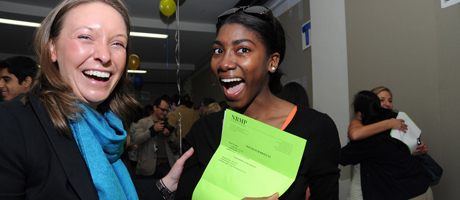By Anna Miller
For some, graduation day represents the culmination of academic experience. For medical students, though, Match Day is more important, says Charles Macri, associate professor of obstetrics and gynecology.
“It is really residency that prepares you for your career,” says Dr. Macri. “This is the beginning of the medical students’ real training.”
GW’s 172 medical students reached that milestone on March 18 in a packed Ross Hall auditorium. On Match Day, held the third Thursday of March each year, fourth-year medical students across the country find out where they will be for residency over the next three to seven years.
At exactly noon, the wait was over, and the students simultaneously ripped open their placement letters from the National Resident Matching Program (NRMP). An eruption of cheers, tears and champagne toasts followed.
“I had to read my letter twice!” said Shivani Bhatt, who matched in her first choice, a pediatrics residency at Children’s Hospital in Philadelphia. “I am speechless. There are just no words to describe how happy I am.”
For Pascale Lespinasse, who also received her first choice--the New York University School of Medicine for an internal medicine residency--the moment was equally surreal.
“I have wanted to be a doctor since I was five, so this is definitely a monumental moment,” she said. “We work really hard, and it is all paying off.”
GW students matched across the country, including at Beth Israel Deaconess Medical Center in Boston, Johns Hopkins Hospital, the Mayo School of Graduate Medical Education, Stanford University, Duke University and the Cleveland Clinic . The most popular residencies were in internal medicine, followed by pediatrics, anesthesiology and emergency medicine.
Prior to Match Day, students across the country were busy applying and interviewing at residency programs. After they ranked their top five choices, a computer system compares their choices to those of the residency programs and creates a match. While not everyone always gets a match, GW students matched at a rate above the national average of about 93 percent.
“GW has been known for a very long time as a school that trains first-rate physicians that really contribute when they get out and work in their residency programs,” said James L. Scott, dean of the School of Medicine and Health Sciences.


